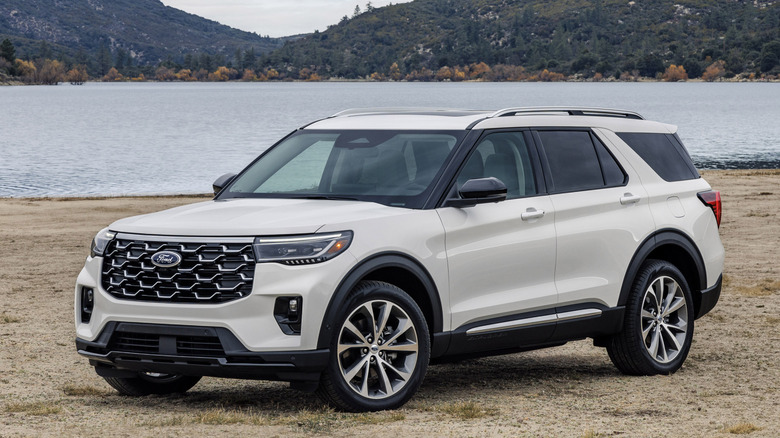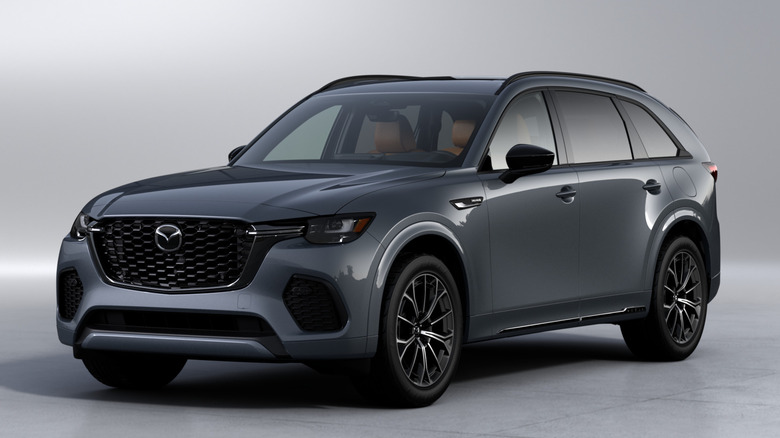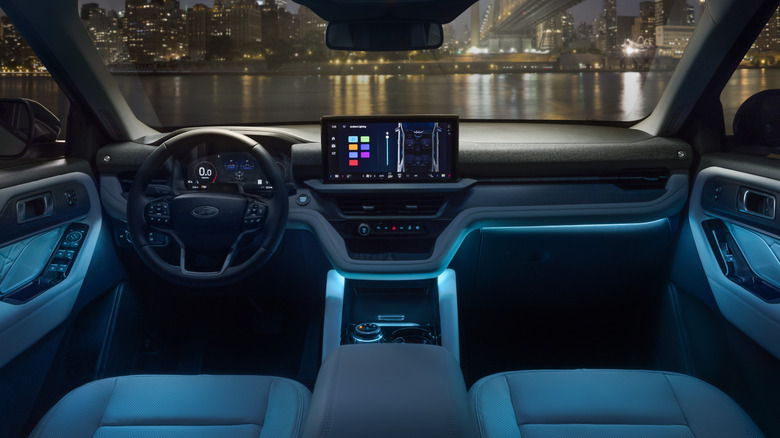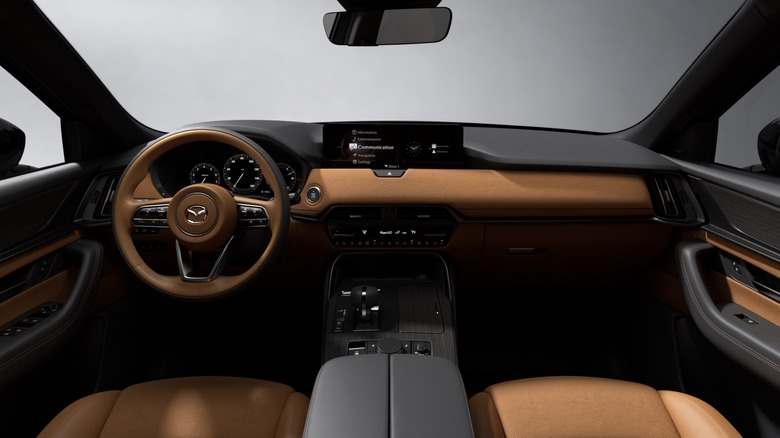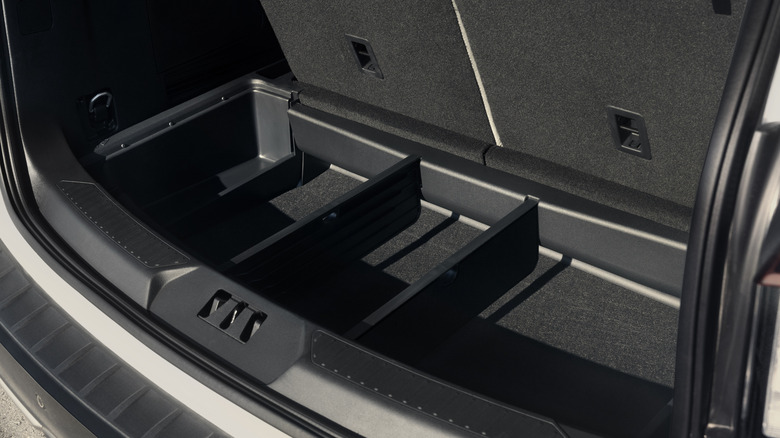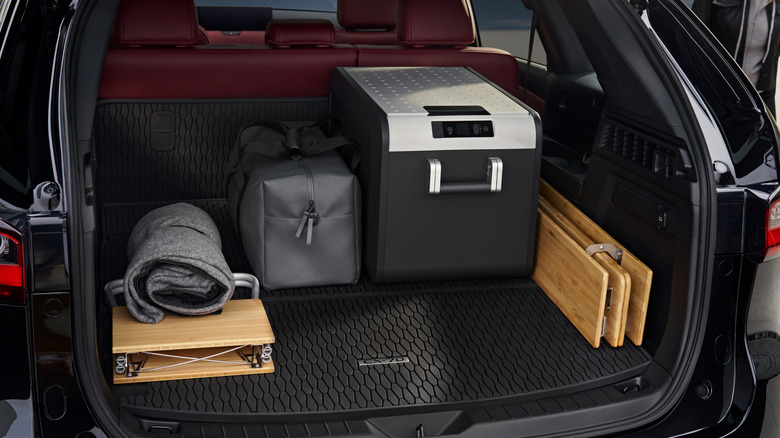Ford Explorer Vs. Mazda CX-70: How Do These Mid-Size SUVs Compare?
The Ford Explorer and the new-for-2025 Mazda CX-70 are both mid-size SUVs. The primary difference between them is that the 2025 Ford Explorer comes with three rows of seats, while the 2025 Mazda CX-70 is a two-row SUV. If you regularly need to carry more than five people at a time, this may be a concern that could lead you to select the Explorer over the CX-70. But if that is the case, it is very helpful to know that there is an identical Mazda mid-size SUV that does come with three rows of seats. This Mazda three-row SUV is known as the CX-90, and except for the third row, there are no other key differences between it and the CX-70. As to why these two otherwise identical SUVs have different names, please direct your inquiries to Mazda.
The Ford Explorer is available in four trim levels — Active, ST-Line, ST, and Platinum. Our 2025 Ford Explorer ST review showed that the extra performance doesn't change what matters. The Mazda CX-70 comes in three trim levels, which include the Preferred, Premium, and Premium Plus.
How do these mid-size SUVs compare in size?
Comparing the size of these two mid-size SUVs shows some interesting differences between them. The 2025 Ford Explorer is 1.4 inches taller than the 2025 Mazda CX-70, while its maximum width without mirrors is 1.3 inches more than the Mazda. But the Mazda wins out on both overall length (2.0 inches more) and wheelbase (3.7 inches more) when compared to the Ford. Fuel tank capacity is nearly identical, at 18.6 gallons for the Explorer and 18.5 gallons for the CX-70. Minimum ground clearance for the Explorer is 7.8 inches, compared to 8.0 inches for the CX-70. Maximum towing capacity for the 2025 Ford Explorer, which is different from payload, is 5,000 pounds. The 2025 Mazda CX-70 with the mild hybrid system is capable of towing 5,000 pounds, while the PHEV can tow 3,500 pounds.
Inside these mid-size SUVs, the Ford Explorer provides a total of 155 cu. ft. of passenger volume in its three rows, while the CX-70 offers 108 cu. ft. for its two rows. This averages out to about the same amount of passenger volume per row. Cargo volume for the Explorer amounts to 16 cu. ft. behind the third row, 46 cu. ft. with the third row folded, and 85 cu. ft. with the second and third rows folded. The cargo capacity of the CX-70 is 40 cu. ft. behind the second row and 75 cu. ft. with the second row folded, somewhat less overall than the Explorer provides.
How do these mid-size SUVs compare in performance?
Three of the 2025 Ford Explorer's four trims (Active, ST-Line, and Platinum) come standard with a 2.3-liter turbocharged EcoBoost inline four-cylinder engine with an output of 300 horsepower. The ST is upgraded to a turbo V6 producing 400 horsepower (the Platinum trim offers this engine as an option). Both engines are mated to a 10-speed automatic transmission driving the rear wheels, but all-wheel drive (AWD) is an option. Performance data, as measured during Car and Driver testing, showed the higher-powered Explorer ST AWD doing 0-60 mph in 5.1 seconds and 0-100 mph in 13.8 seconds, which matched its quarter-mile time. Roadholding on a 300-foot skidpad was .83g.
The 2025 Mazda CX-70 has two drivetrain options — a 48-volt mild hybrid using a 3.3-liter turbocharged inline six to produce either 280 or 340 horsepower and a Mazda CX-70 PHEV (plug-in hybrid), which our tester found to be luxurious and agile. The PHEV combines an inline four-cylinder engine with an AC electric motor, generating a total of 323 horsepower. Both CX-70 drivetrains are mated to an eight-speed automatic transmission and have AWD standard. In Car and Driver testing, the 340-horsepower version of the inline six did 0-60 mph in 6.2 seconds and 0-100 mph in 15.3 seconds, with the quarter-mile in 14.8 seconds at 98 mph. The PHEV pulled 0-60 mph in 5.9 seconds and 0-100 mph in 15.2 seconds, with the quarter-mile taking 14.4 seconds at 97 mph. Roadholding on the skidpad was .86g for the six and .82g for the PHEV.
How do these mid-size SUVs compare in fuel economy?
As most people know, the economy numbers you achieve depend on many different factors — whether you drive on city streets or interstate highways (and why you get more mpg on the highway), whether you drive in the mountains or in flat areas, whether you have a "lead foot" or you drive for economy, whether you drive a small car or a large truck, and so on. But thanks to the EPA, we do have estimated numbers backed by testing that we can use to compare the 2025 Ford Explorer and the 2025 Mazda CX-70. To keep things simple, we will only use the Combined City/Highway EPA mpg ratings. As always, your mileage may vary.
The 2025 Ford Explorer provides different sets of EPA numbers from its two different drivetrains, plus sometimes varying numbers for RWD and AWD versions. The 2.3-liter inline four engine with RWD provides 24 mpg, while the AWD version gets 23 mpg. The 3.0-liter V6 delivers 21 mpg for both RWD and AWD.
The 2025 Mazda CX-70, which has AWD standard, also has two different drivetrains, a mild hybrid 3.3-liter inline six and a PHEV with an 2.0-liter inline four. The mild hybrid gets 25 mpg combined. The PHEV, which can go 26 miles on electric power after a charge, gets an amazing 56 mpg when running on both electricity and gasoline, managing 25 mpg on gasoline alone, the same as the mild hybrid version. However, the PHEV requires premium gasoline, according to the EPA.
How do these mid-size SUVs compare in infotainment?
The infotainment system in the 2025 Ford Explorer comes with a 13.2" LCD touchscreen. The system can access Amazon and Google for both services and apps through its new Ford Digital Experience software. The Explorer's infotainment is also compatible with Android Auto and Apple CarPlay. Three 12V power outlets and eight USB ports are sprinkled throughout the interior. Additionally, on all trims except for the base model Explorer Active, a Bang & Olufsen 12-speaker audio system is standard equipment.
The 2025 Mazda CX-70's infotainment system incorporates a 12.3" center screen, but instead of a touchscreen, the CX-70 uses console buttons combined with a control knob to operate its system. Amazon Alexa can be integrated into the system, while it is also compatible with devices using Apple CarPlay and Android Auto. Trim levels above the least expensive Preferred receive a standard Bose audio system with 12 speakers, with options of a head-up display and digital gauges available to Mazda CX-70 buyers. It's worth noting that Mazda was recently sued over its infotainment systems.
How do these mid-size SUVs compare in price?
The base price for the entry-level 2025 Ford Explorer Active with rear-wheel drive (RWD) is $40,050 MSRP, plus $1,695 destination charge. Explorer pricing tops out with the high-performance Explorer ST RWD, which will set you back $54,770 MSRP, with the same destination charge added. In between lie the Explorer ST-Line at $45,020 MSRP and the Explorer Platinum at $52,525 MSRP. AWD adds $2,000 to your total. A wide variety of options and accessories are available, some depending on the trim level you select, including non-standard paint colors ($495 to $795), Ford BlueCruise hands-free highway driving ($495 for one year, standard on Platinum), a black painted roof ($4,895!), a panoramic vista roof paired with a Bang & Olufsen 14-speaker audio system including a subwoofer as well as other options ($2,995), upgraded wheels, and much more.
Pricing for the 2025 Mazda CX-70 starts at around the same price as the 2025 Explorer, $40,445 MSRP for the mild hybrid 3.3 Turbo Preferred trim, with $1,455 added for destination charges. The most expensive CX-70 in the lineup is the PHEV Premium Plus, which stickers at $57,450 MSRP plus destination. Priced between these extremes are the 3.3 Turbo Premium at $45,900 MSRP, the 3.3 Turbo Premium Plus at $48,900 MSRP, the 3.3 Turbo S Premium at $52,450 MSRP, the PHEV Premium at $54,400 MSRP, and the 3.3 Turbo S Premium Plus at $55,950 MSRP. CX-70 options include non-standard paint colors ($450 to $595), towing packages ($700 to $900), and a large selection of dealer-installed accessories.
